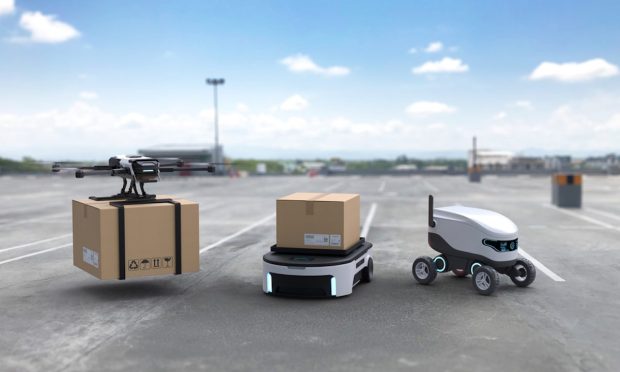Tortoise Shifts Focus Of Automated Delivery To The Present

Even with the delivery boom that began in 2020, major food delivery services continue to operate at a loss. DoorDash recently reported its fourth consecutive quarter of losses, and Uber Eats and Grubhub also continue to incur losses. With grocery-first services such as Instacart, changing gig economy laws and increasing competition threaten to overhaul the model.
See also: Fixing The ‘Broken Economics’ Of Grocery Delivery
Related news: Prop 22 Reversal Could Strain Food Delivery Volume With New Fees
Given the sky-high demand for delivery, something has to give. PYMNTS data from our study The Bring-It-To-Me Economy: How Online Marketplaces And Aggregators Drive Omnichannel Commerce, created in collaboration with Carat by Fiserv, find that 67 percent of consumers who now routinely order food from restaurants for delivery or pick up to eat at home. Additionally, 72 percent of consumers are now more ordering groceries online as compared to before March 2020, and of this, 28 percent are ordering groceries for curbside pickup and 27 percent are ordering groceries for home delivery.
If businesses want to capture the demand for delivery in a profitable way, the model will have to change. However, many of the labor-saving initiatives being pilot tested will not be feasible for years to come.
“Our founding contrarian insight was, when it comes to automation on public rights of way, we’re still a long, long ways away from full on self-driving cars taking you wherever you want to go,” Dmitry Shevelenko, co-founder and president of last-mile logistics robotics company Tortoise, told PYMNTS in an interview. “That’s in a distant future. I’m looking forward to it, but we’re not there yet. But in terms of existing technologies that you can deploy at massive scale … part of this is already accessible today.”
In the spring, Tortoise announced a partnership with grocery giant Albertsons Companies to pilot remote-controlled cart deliveries with Albertsons’ Safeway supermarket brand in Northern California, and this month, the robotics company announced a partnership with Dallas Urban Value Corner Stores to bring everyday goods to consumers in the area.
Read more: Albertsons Teams With Tortoise For Robotic Grocery Delivery
Also see: Tortoise, Vroom Delivery To Launch Robotic Grocery Delivery In Dallas
The Technological Roadmap
Shevelenko believes that many companies developing automated technologies are putting the robotic cart before the robotic horse, noting that Tortoise focuses on what is feasible in the near term.
He describes the timeline for evolution of automated vehicles as “low speed before high speed, light mass before heavy mass, and remote control before autonomous.”
Hence, Tortoise’s 4-mph remote-controlled carts, which weigh under 200 pounds and can carry 120 pounds. The company’s robots operate over the area’s 4G network, coasting down sidewalks, bike lanes and the side of the road to fulfill deliveries within a 3-mile radius.
These vehicles are piloted by remote drivers, whom Shevelenko describes as “like a call center worker,” guiding deliveries in all the markets in which Tortoise has a presence. While the model does not achieve the labor savings that a fully autonomous vehicle might down the line, it is significantly more efficient than the gig model that leading third-party delivery services use. Rather than relying on having a worker available in the area, a model with built-in downtime in which no one is making a profit, remote drivers can fulfill orders throughout their shifts.
The Grocery Sweet Spot
Robots such as those designed by Tortoise are feasible for both grocery and restaurant orders, depending on the delivery radius, though Tortoise is primarily focused on grocery for now.
“One of the reasons we really aren’t focused on on-demand hot food is, when you order on-demand hot food, you want it right away,” Shevelenko said, “whereas with grocery, one-hour delivery is still awesome.”
He added that consumers expect lower-value purchases such as a single burrito in less time than they expect higher-value purchases such as a grocery order, making grocery deliveries both more profitable and more achievable. For a 4-mph cart to deliver a restaurant order within fifteen minutes, for example, the delivery radius has to be limited to a single mile.
Regarding the new convenience store partnership with Urban Value, he added that a 2-mile radius works well.
“Thirty minutes feels like the right window for convenience. Convenience is, I’d say, somewhere in between grocery and hot food in terms of the urgency,” he said, “so we’re just more on the money.”
Becoming Instacart-Proof
While many try to position their services as the solution to grocers’ delivery challenges, Shevelenko sees Tortoise’s offerings as meeting a specific use case — deliveries within a relatively short radius — while vendors will continue to rely on other delivery providers for longer-radius deliveries or for orders that require careful handling by a human. He believes that the leading strategy for vendors is to reduce dependence on any one provider by utilizing as many services as possible.
As an example, he noted that, if Instacart begins fulfilling orders through its own dark store, as it has been exploring and as DoorDash has begun to do with ghost kitchens, grocers dependent on the platform could face a crisis. By utilizing as many providers as possible, grocers can adapt and shift as needed.
“I think the savvier grocers and retailers don’t want to have a single dependency in ecommerce,” he said. “Two, three years ago, that wasn’t a problem, because eCommerce was still a relatively small part of their business, but … you can’t now have 20, 30 percent of your business evaporate, just because the one player you’re relying on shifts their strategy.”
